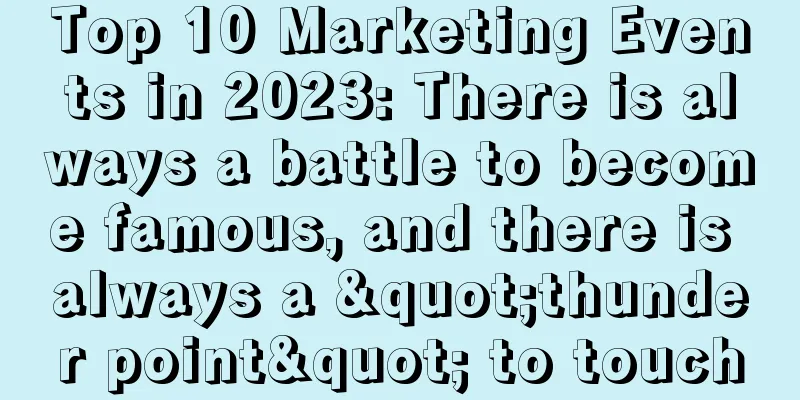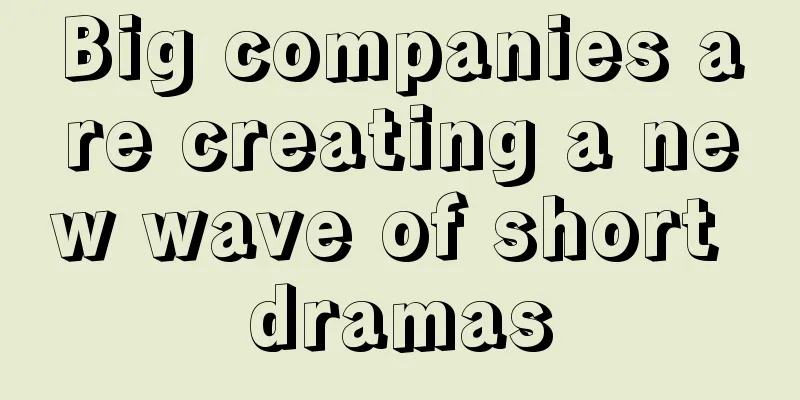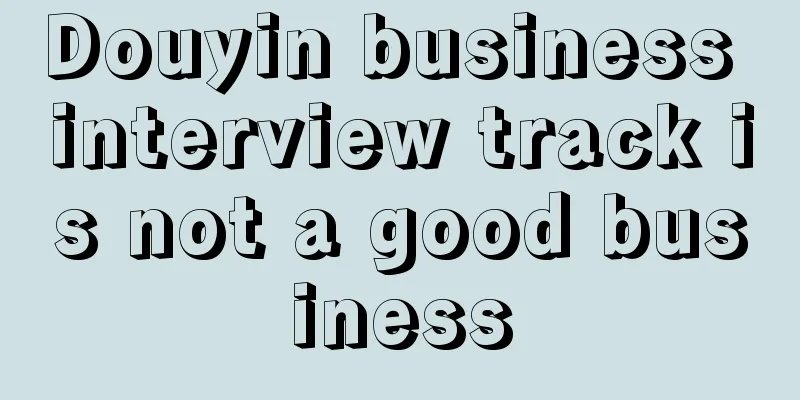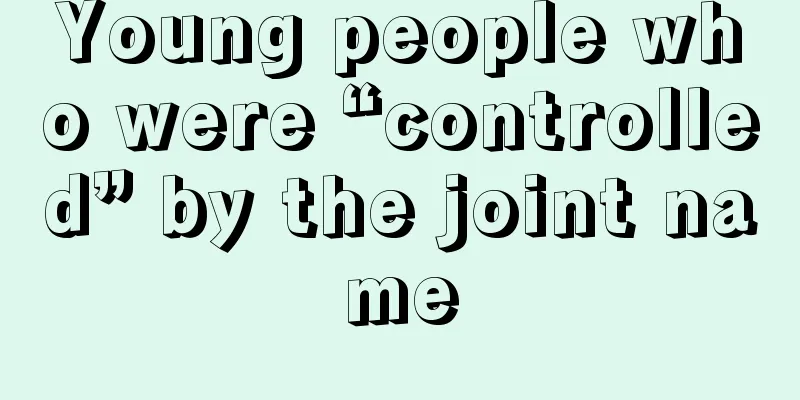Why can Coca-Cola transcend cycles but Zhong Xue Gao can’t?
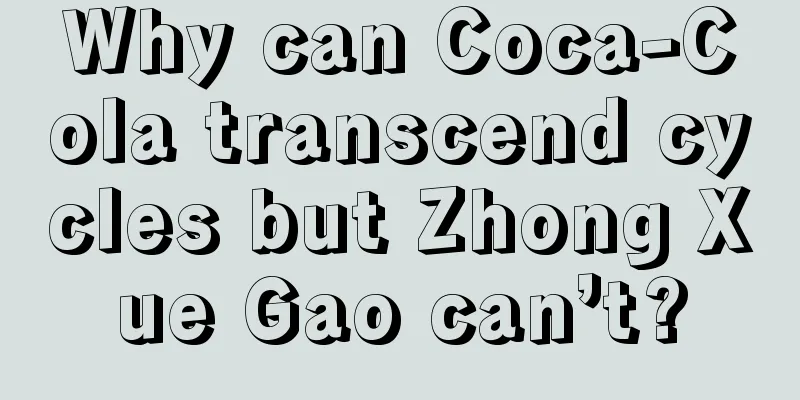
The marketing industry has entered a difficult phase, and the new ways of driving marketing in the past few years are gradually becoming ineffective. After several years of popularity, live streaming has gradually calmed down, and the enthusiasm and impulse buying effects it brought are gradually weakening. Similarly, the "grass planting" strategy, which was once regarded as a marketing tool, has gradually become rampant, and users have a crisis of trust in the products recommended by KOLs and Internet celebrities, and the ROI is getting lower and lower. In general, in today's marketing environment, traffic is becoming increasingly scarce and the cost of acquiring it is getting higher and higher. In order to maintain exposure and conversion, brands have to invest more budget to compete for increasingly expensive traffic. At the same time, traditional brand building methods - shaping brand awareness through content creation and advertising - are often forced to be shelved because of their long payback cycle and inability to produce quick results. Faced with the dilemma of lack of traffic, many brands have fallen into the vortex of short-termism: the harder it is to find traffic, the more desperately they chase it, eventually falling into a vicious cycle. Such a choice has brought many sequelae, which is the fundamental reason why many brand marketing are facing difficulties nowadays. 01 The aftermath of pursuing short-term trafficThe essence of pursuing short-term traffic is not investing enough in products, brands, and user experience, and rushing to increase traffic and gain revenue. This leads to the following problems: 1. Chasing hot spots, the dividends are quickly consumedThe advantage of rapid changes in the marketing industry is that everyone can keep up with the times quickly, but the disadvantage is that the dividends are consumed too quickly. In the past, when a new marketing method emerged, most brands would wait and see, analyze its value and applicability, and then gradually enter the market. In this way, the benefits would be consumed more slowly, and the market cake could be divided up bit by bit by brands, and most brands could get some. Now when a new marketing method comes out, everyone rushes to get in, fearing that they will be too late and not even get a crumb of the cake. Because too many brands come in too quickly, the cake is quickly divided up and the dividends are quickly exhausted. For example, the bonus period of television advertising lasted for decades, but now emerging models such as live streaming sales have risen and the bonus period has disappeared in just a few years. The speed of shortening the bonus period is astonishing. 2. ROI trap and path dependenceBrands’ pursuit of short-term traffic is often accompanied by a high dependence on ROI. In the early days of traffic marketing, due to less competition and relatively high ROI, brands increased their investment and formed path dependence. However, as time went on, ROI dropped rapidly, and brands found it difficult to extricate themselves and could only continue to increase investment in the hope of maintaining the effect. This dependence is like a drug: the dosage keeps increasing, but the effect becomes worse and worse. Even though it is recognized that this strategy is unsustainable, brands have to continue struggling in the quagmire of ROI because no better marketing path has been found. 3. Over-reliance on influencer marketing and lack of independent channelsInfluencer marketing is one of the important means of marketing today, but its effects are often unstable. It may sell well today, but suddenly fail tomorrow. As influencer marketing becomes more popular, consumers are becoming tired of the large amount of recommended content, resulting in a decline in marketing effectiveness. In fact, the ROI of influencer marketing has been gradually declining over the past year. Relying on influencers for marketing is actually placing the fate of the brand in the hands of others. Many brands rely too much on influencers and neglect the construction of their own channels and long-term brand cultivation. Once influencer marketing fails, the brand will be at a loss. 4. Over-reliance on data and neglect of consumer emotionsOne of the traffic-first thinking is over-reliance on data. Data-guided marketing is inspired by the operational thinking of the Internet. Although data does bring precise delivery and optimization effects to marketing, over-reliance on data also causes brands to ignore the emotional connection with consumers. Marketing is not just about data, it is also about art. If a brand over-relies on data and ignores the emotional resonance with consumers, it will only make consumers feel indifferent and alienated towards the brand. Just like the popular saying "I treat you as a friend, and you treat me as private domain traffic." 5. Short-term promotions and discounts erode brand valueWith consumption downgrade and a traffic-first environment, many brands have begun to increase the frequency of promotions or sell products at lower prices. Promotions can boost sales in the short term, but the disadvantages are also obvious. Selling at a price lower than the market price sends a signal: your product is too expensive, so it will be very difficult to raise the price again in the future. Short-term promotions don't really win over consumers. If someone buys a brand just because it's on sale, they usually don't have much brand loyalty. Professor Ellenberg commented on this behavior: "A price reduction can entice people to try a brand, but they immediately return to their familiar brands as if nothing had happened." In general, excessive promotions and price cuts will bring in short-term traffic, but will damage brand value in the long run. 02 Marketing returns to its classical valuesFragmented information has dominated the content and marketing world in the past few years. Since the beginning of this year, there have been signs of recovery in deep value content. For example, some brands have mentioned long-termism more and more frequently, some brands have begun to reduce live streaming and return to shelf e-commerce, and medium and long videos have begun to gain favor. These were considered classical in the past, but one trend today is a return to classical values. 1. Marketing: Returning from traffic to brand buildingTraffic can bring short-term exposure and sales, while branding can bring fame, reputation and trust. I have previously written an article titled "Livestreaming determines how much you can sell, while branding determines how much you can sell", which expresses this idea. Brand building has the following characteristics:
The difference between brand building and traffic marketing is that once a brand is established and deeply rooted in people's hearts, sales will not be immediately affected even if the subsequent investment is reduced. This brand effect is similar to the scale effect of an enterprise. As the user scale increases, the marginal cost gradually decreases, thus forming a competitive advantage. Traffic marketing is the opposite. Once the investment is stopped, sales will immediately drop sharply and lack sustainability. Just like brands like Coca-Cola and Procter & Gamble, they have established deep brand recognition and loyalty in the hearts of global consumers through decades or even hundreds of years of efforts. Building and maintaining a brand is a long-term project, but once successful, it will bring continuous returns to the company. 2. E-commerce: From live streaming to shelvesThe core of live streaming e-commerce is traffic-driven, and only a steady stream of traffic can drive sales growth. However, as mentioned above, the traffic cost of live streaming is increasing, and the instability of traffic is becoming increasingly apparent. As a result, many brands have begun to reflect on the nature of e-commerce and re-examine the importance of shelf e-commerce. As the earliest form of e-commerce, shelf e-commerce has existed since its birth. Although traffic still plays an important role in it, the brand itself is the real decisive factor. When you walk into a shopping mall, sometimes you may just browse around, but many times, you go directly to your favorite brand store to see if there is any product you want. This brand attraction is one of the core logics of shelf e-commerce. Similarly, when consumers really need to buy a product online, they often search for the brand directly, or compare multiple brands before placing an order. This purposeful consumption method is fundamentally different from the randomness of live streaming. Livestreaming attracts users who are looking for discounts and promotions, which leads to one-time consumption and makes it difficult to form long-term brand loyalty. However, shelf e-commerce is different, as it relies on brand stickiness and long-term user trust. As long as the brand is managed properly in the long term, the value of the brand will be reflected when consumers search for the brand name directly in the search box or notice your product first when browsing a certain category. Making good shelves is the fundamentals of a brand. If it is managed well in the long term, it can bring in relatively stable income no matter what the environment is. However, live streaming can only add icing on the cake and it is difficult to provide timely assistance. 3. Content: From fragmentation to deep valueOn short video platforms such as TikTok, the popularity of medium-length videos has become a new trend. For example, some medium-length videos analyzing classic literary works, such as Dream of the Red Chamber, have attracted a large number of viewers. This is a return to classical values. Classical does not mean backward. Most of the things that can be called "classical" are classics. This is true for classical music, classical philosophy, and classical economics. While short videos quickly attract users' attention, they are also gradually criticized for their fragmented and low-value content. More and more consumers realize that the time they spend on short videos cannot bring lasting value experience, and thus begin to turn to more in-depth content. This return to in-depth content is actually a renewed emphasis on "classical values". For brands, they cannot just rely on short-term bursts of short video content, but should focus on the long-term influence of text and video stories. Many foreign brands have been continuously delivering their brand values through official blogs, brand concept videos, etc. These contents can influence consumers’ cognition and decision-making for a long time. For example, the official story of Apple is shown below. In China, brands also need to return to the creation of this kind of in-depth content, using text and medium-length videos to tell brand stories and shape brand images. These contents can not only establish a better emotional connection with users for the brand, but also allow consumers to maintain their memory and loyalty to the brand for a longer period of time. In contrast, although short videos can bring brief exposure to the experience, they are often “forgotten after watching once” and it is difficult to form long-term brand sedimentation. 4. Social media: from influencers to word of mouthTo this day, I still believe that word-of-mouth marketing is the highest level of marketing. Word-of-mouth marketing first requires that the product and service must be the best in the market. To achieve this, as long as there is the first batch of media attention or consumer purchases, it will form a ripple effect, obtain more earned media, and drive consumers to line up to buy. I have written about Yeti in a previous article. Yeti's products initially spread from fishing and hunting enthusiasts to skiing, outdoor and other groups through word of mouth. When Yeti expanded into the thermos product line, it quickly gained wide recognition among college students and became one of the products that students aspire to own. In this group, various creative emoticons of Yeti products became popular on social networks. In its early expansion strategy, lululemon did almost no advertising and did not seek celebrity or star endorsements, but instead relied mainly on word-of-mouth marketing. Founder Chip believes that advertising and endorsements can only bring short-term attention, while word of mouth is the foundation for the long-term development of a brand. Lululemon's high-quality fabrics and unique flat seam design make yoga pants very comfortable to wear, so many people wear them not only when exercising, but also when going out. The popularity of this way of wearing has made lululemon yoga pants a beautiful sight on the streets. Some celebrities and stars have also begun wearing lululemon yoga pants in public. For example, Madonna, Jennifer Aniston, Gwyneth Paltrow and others are all loyal fans of lululemon and they often wear lululemon yoga pants on the streets. As more and more people choose to wear lululemon yoga pants in their daily lives, they have gradually become highly exposed mobile advertisements. Another manifestation of word-of-mouth marketing is that products always get earned media. Around 2012, when Apple was at its peak, marketing director Phil Schiller said in an interview that Apple no longer needed to do any advertising when launching new products. The company relied on only two strategies: relying on positive media ratings to build momentum for its products; and having its products appear in TV shows and movies. These two strategies are actually earned media. I wrote in "Why Can't Bad Guys in Movies Use iPhones?" that Apple's placement in movies and TV shows is free. The same is true for Tesla. It is no secret in the industry that Tesla does not do paid advertising, but it has never lacked news attention, and a large number of media and fans promote Tesla for free. For these brands, internet celebrities do not play a very high proportion in marketing. Building good relationships among brands, products and users, and then relying on real word-of-mouth marketing will be far more effective than internet celebrities. 5. Users, return from promotion-driven to emotional connectionPromotions and price cuts can indeed quickly bring in traffic in the short term and attract a large number of consumers to buy. However, this kind of marketing driven by low prices can often only leave a single impression in the minds of consumers - low prices. In addition to low prices, the other values of the brand are almost blank. What really makes consumers pay for a brand in the long run is the emotional bond they establish with the brand. A typical example is the relationship between Apple and its loyal user group, "Apple fans". Apple rarely relies on promotions or price cuts to stimulate the market, but Apple fans continue to pay for Apple products because of the emotional connection they have formed with Apple over the years. This emotional connection is not only reflected in the products, but also in the values conveyed by the brand, the spirit of innovation, and the humanized design behind the products. Many brands are trying to build longer-lasting relationships through emotional communication with users. Through content creation, advertising and brand activities, brands can leave a deep impression in the minds of consumers. Although these emotional communications may not translate directly into sales in the short term, they create long-lasting memories and brand recognition. At some point in the future, these emotional connections will become an important reason for consumers to choose the brand's products. 03 Why Coca-Cola can cross the cycle, but Zhong Xue Gao cannotRecently I have been thinking about a question: Why has Coca-Cola been able to survive through more than 100 years of ups and downs, while Zhong Xue Gao can no longer survive after encountering just a few minor problems? This reflects the essential differences between the two in terms of brand building. On the basis of making good products, Coca-Cola has been continuously building its brand over a long period of time. Through continuous advertising investment, it has continuously strengthened its brand image around the world and conveyed core values such as happiness and sharing. Over the years, this brand building has not only made Coca-Cola synonymous with "beverage" in the minds of consumers, but also provided it with strong risk resistance in different market cycles. On the contrary, when Zhong Xue Gao's product strength was not yet solid, it was eager to pursue short-term traffic and exposure through methods such as seeding marketing. Although this traffic-driven marketing strategy may bring certain sales performance in the short term, it has not established a solid brand image and consumer trust. Once there are problems with the products or the market environment changes, the fragility of these brands will be immediately exposed, causing the brand image to collapse and operations to become unsustainable. The difference between the two is that Coca-Cola has continuously invested in brand building on top of its stable products to create a solid brand recognition, while Zhong Xue Gao over-reliant on traffic and short-term marketing when its products were immature, ignoring long-term brand accumulation. In today's fiercely competitive environment, the goal of many new brands may be to "survive today and talk later", but I believe that brand building cannot make you lazy. If you don't pay attention to the long-term development of the brand now, the cost of making up for it in the future will only be higher. |
<<: Unveiling Decathlon’s private domain layout: How can sports brands break through?
>>: Revealed! How do we produce and store popular articles?
Recommend
The Tianshui Malatang, which is "copied and pasted" everywhere, has changed its taste
During the Qingming Festival, my country's tou...
The longest Double Eleven in history has begun. What new benefits can be gained?
This year's Double 11 not only has a longer pe...
What is cross-border e-commerce operation? What are the daily tasks of operation?
There are many merchants doing cross-border e-comm...
Does Amazon FBA need to pay taxes? Detailed answer
When merchants do business, they will be involved ...
Rebirth: I am doing e-commerce operations
This article uses a fictional story to tell how an...
Do copywriting that ChatGPT cannot replace
This article starts with the underlying logic of C...
Elderly UP hosts "occupy" Station B
Are elderly UP masters pursuing their dreams on Bi...
What products are good to sell on Amazon? How to sell products?
Amazon has always been a product-oriented platform...
What should I do if I have to work overtime late at night in a cross-border e-commerce business? Are cross-border e-commerce salaries high?
Cross-border e-commerce platforms are challenging ...
Content e-commerce, a panacea for TVB to realize monetization?
Last September, Taobao Live began to enter the &qu...
How to place Amazon video ads? What are the strategies?
No matter which platform you open a store on, as l...
Interpretation of the Prohibition and Restriction Rules of Alibaba International Station Announcement on Changes in Controlled Devices
To further regulate the development of the platfor...
Differentiate online content forms and choose appropriate growth methods
There are many forms of online marketing content, ...
What should I do if Wish has an order but there is no product? How can I remedy this?
When opening a store online, merchants must pay at...
Millions of dollars spent just to change a name? Three repositionings that Lao Xiang Ji didn’t tell you about
Have you ever wondered if the trend of Lao Xiang J...

